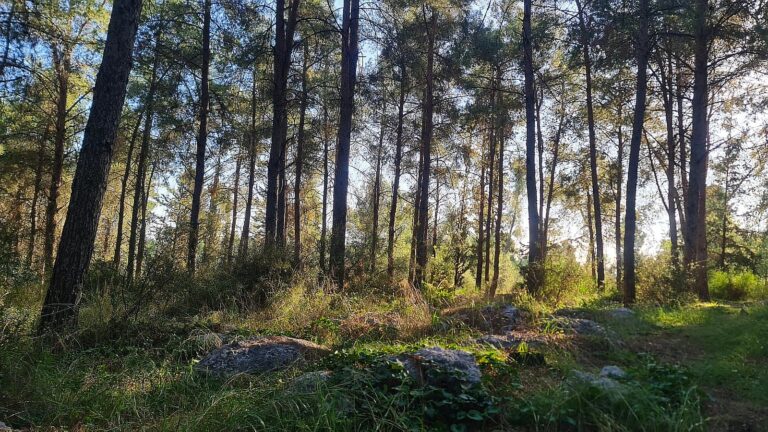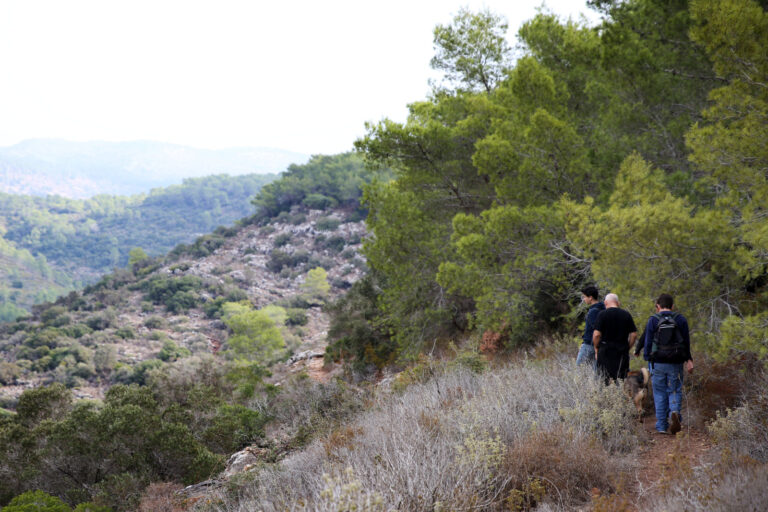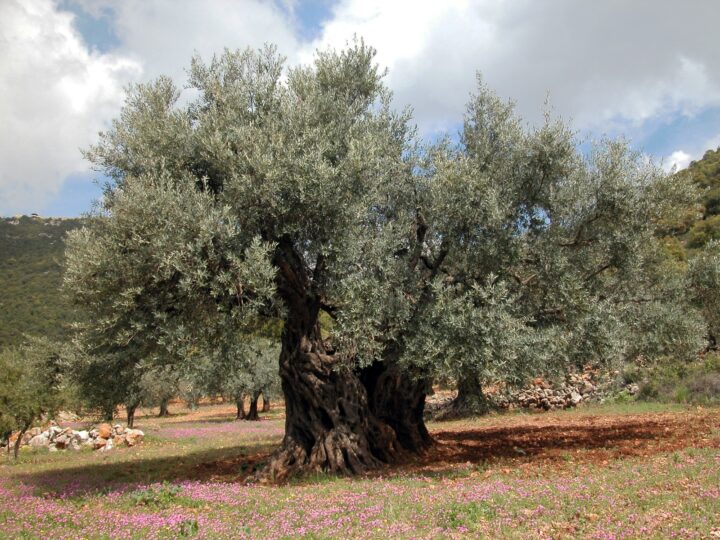At first mention, forest bathing sounds like another millennial schtick. But it really isn’t. Call it a good brisk walk, a hike, or even shinrin-yoku, as they do in Japan, and picture the unrivaled relaxation of being quietly surrounded by green.
Here in Israel, we can all certainly do with some respite from our daily life. Ahead of the International Day of Forests, celebrated around the world on March 21, we’ve compiled the best forests in Israel that offer fun, relaxation, amazing scenery and even a spot of history.

We enlisted the help of Anat Gold, director of the central region at Keren Kayemeth LeIsrael – Jewish National Fund (KKL-JNF), to learn more about the history of forests in Israel.
“You can define forestry periods in Israel in decades,” Gold tells ISRAEL21c.
“The 1950s were a decade in which mass planting of the forests that we know today, like the Jerusalem Forest, the Kedoshim Forest and Shacharia and Biriya, were planted,” she says.
In the 1970s and 1980s, the forests were ready for picnicking and sports activities.
“Nowadays, the forests are in fact open-air museums. They encompass landscape, culture and heritage. This creates a wide range of activities, whether for people who enjoy hiking or seeing flower blossoms, people who cycle or ride horses, and of course the general public that enjoys picnicking – we offer a very wide range of activities and sites that are accessible to people with disabilities.”
KKL-JNF, Gold adds, oversees nearly 250,000 acres of planted forests across the country.
“The country is divided into three different climate zones, from Mediterranean in the north to semi-arid and desert in the south, and that also affects the ways forests look and the type of trees that we have,” she explains.
“We have huge variety in terms of forests, from the acacia savannah in the south to the pine and cedar trees of the north. In the center of the country, we have a mostly Mediterranean climate that comes across in species such as almond trees, pines and jujube trees.
“Our goal is to safeguard and maintain all the different landscapes of Israel, and that’s why our forests are of different kinds,” she notes.
1. The Sataf

The Sataf refers to a gorgeous water spring surrounded by agricultural terraces, beautiful greenery and almond trees.
Numerous hikes can be enjoyed in the area, as well as conveniently placed picnic tables and a few coffee options nearby. The Sataf’s popularity means that it won’t be the most solitary experience, especially on the weekend, but a few hours spent there certainly lift the spirit.
2. Jerusalem Forest

The Jerusalem Forest is Gold’s personal favorite, having grown up in the area and now managing it for the KKL-JNF. “For me, it’s a forest with so many childhood memories, and nowadays it also offers so much activity.”
The Jerusalem Forest was planted in 1956 but has grown smaller in recent years due to roadworks and neighborhood expansions. And yet, it still offers a very peaceful green lung to the residents of the city. It includes campsites, picnic sites, viewpoints and bicycle paths. It can easily be accessed by foot, bus, train and car, but still maintains an air of quiet and countryside.
3. Hulda Forest

The Hulda Forest in central Israel offers visitors great greenery and a good slice of Israeli history. The forest dates to 1904, when olive trees were planted in the area to commemorate Zionist leader Thedore Herzl, who died that year. A few years later, almond, cypress and carob trees were also planted, followed by pine trees put in place by the nearby residents of Kibbutz Hulda.
The result is one of Israel’s first forests, containing the historic Herzl House with its gallery and information for visitors. There’s a famous memorial in the forest, as well as remains of the water pipeline that once served the area.
4. Ben Shemen Forest

Ben Shemen Forest, also located in central Israel, welcomes over a million visitors each year.
The forest is rich with Zionist history: The area was purchased by KKL in 1907, and various enterprises such as a short-lived national agricultural school, educational farm and a goldsmith village were established onsite, as well as residential communities.
Nowadays, the huge forest offers visitors picnic spots, hiking trails, playgrounds, sports equipment, a recreation area for the blind and even the Israel-Thai Friendship House, which looks like a Thai temple.
5. Ilanot Forest

The famous, prize-winning Ilanot Forest in the Sharon region of central Israel is an arboretum, or botanical garden for trees, planted in the 1950s and managed by KKL-JNF.
“The arboretum presents more than 700 tree species from around the world, ordered by countries and continents,” Gold notes.
“We conduct a lot of research on the plants there and their acclimatization. The arboretum also boasts hiking routes and a visitors’ center.”
6. Carmel Forest

When you say “Carmel Forest” in Israel, most people’s minds wander to the famous spa and resort of the very same name.
But the actual Carmel Forest in which the hotel is situated is no less of a wonder. Located in the Haifa area, the forest boasts a Mediterranean climate and vegetation, sea views and even groundbreaking archeological sites, since it has been home to humans since prehistoric times.
The Carmel Forest suffered Israel’s worst forest fire in 2010, which led to the loss of many lives and to great damage to the forest itself. Rehabilitation efforts have been successful in ensuring the area is still one of the prettiest – and greenest – in the country.
7. Haruvit Forest

Haruvit Forest in the coastal plains of Israel combines the past and present, bordering as it does on the ancient city of Gat, where the biblical Goliath came from, and as such is archeological heaven. The park is also a fun destination for the whole family, boasting bicycle trails, hiking trails and picnic tables. And every bit of it is completely accessible to wheelchairs and strollers.
Haruvit Forest is also home to Halohem (Soldier) Park, developed with the IDF Disabled Veterans Organization and including accessible playgrounds and accessible mini soccer and basketball fields.
8. Yeruham Park

Yeruham Park, located on the outskirts of the desert town of Yeruham, is home to many trees, flowers and a manmade lake, and offers a touch of green in an otherwise arid landscape.
The forest was first planted in the 1950s and further developed in the 1980s. It is now home to an array of trees, such as pistachio, eucalyptus, date palms and olive trees. In autumn, it is a great spot to catch the yellow crocus blooms, and in winter the iris blooms. The accessible park includes picnic tables and recreation area by the lake.
9. Yatir Forest

Yatir Forest in southern Israel is famous for being planted in the early 1960s in a semi-arid landscape.
Today, is it home to many types of trees and vegetation, as well as an extensive array of archeological findings, including a synagogue that operated up to the eighth century, caves that were used as cellars in ancient times and even the remains of a fortress from the era of the Judean kings.
The forest’s many trails pass through ancient cisterns, olive mills and grape-treading floors. The various routes are dotted by great viewpoints.
10. Be’eri Forest

Unfortunately, we cannot recommend that you go visit Be’eri Forest anytime soon. The forest is adjacent to the communities that were attacked and slaughtered by Hamas on October 7, and access to the area is currently prohibited to civilians.
But it belongs on this list in the hope that soon people will soon be able to enjoy its amazing bicycle trails, famous “Darom Adom” (Red South) anemones, ancient ruins and a memorial for the Australia and New Zealand Armored Corps who fought in the area in World War I.
May peace be restored to the region, and may we find solace in these beautiful surroundings once again.















